|
 Vicki Fishlock asks... Vicki Fishlock asks...
Care to Donate Now?
(Vicki is ATE's Resident Scientist)
|
|
The Case Against ATE Staff
| |
Everyone by now has heard the sad news that one of our oldest and most loyal team members, Soila Sayialel and her son, Robert Ntawuasa, were arrested on May 12 allegedly for possessing and attempting to sell 19 kg of ivory. The whole ATE team, and huge numbers of Soila's supporters in Kenya and abroad are in a state of shock, disbelief, and most importantly, in total support of their innocence.
We can say very little at this point as the case is sub judice, but we feel to our Newsletter family of readers we must state the following:
We are 100% behind these two ardent conservationists, who have been for many years (more than 25 in Soila's case) an example of the kinds of dedication and energy that a growing number of today's Kenyans, in particular women and youth, are willing and able to put into conservation of their natural resources and ecosystems.
We are confident that given what appears to be absurdly weak evidence for the prosecution the case will be dismissed very soon. It is not only in our laypersons' view that the episode appears to be a frame-up.
We believe that given the dreadful expansion of the illegal trade of ivory into the realm of international crime, the whole sorry event is likely to be the result of criminal elements seeking to defame ATE and drive a wedge between ATE and KWS. Why? Because together, ATE with its eyes and presence in the ecosystem and KWS with its mandate and ranger force stand between the poachers and what must be the last source of 'big ivory' in Kenya, if not the East African region. Remove us, and it's open season on the Amboseli elephants.
Please bear with us. We are confident that the truth will out very soon. Thanks for your understanding.
|
|
Student Achievements
|
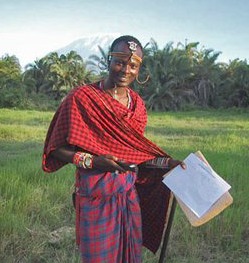 | |
Patrick as a promising scout in 2003, already having mastered the GPS and data-recording
|
| |
ATE has a university scholarship program for young men and women from the Maasai community surrounding Amboseli. Recently two of our students have attained important positions in the Kenya government.
First we got word that Patrick Papatiti had been appointed as Liaison Officer to the Chief Parliamentary Whip, Katoo Ole Metito, the MP for the area including Amboseli. Patrick was one of our Elephant Scouts about 10 years ago. He went back to school at age 27 to complete secondary school, scored very high marks, and went on to university. We, along with BEADS for Africa, supported his university degree. We believe Patrick will be an important ambassador for the Maa community as well as for conservation.

Recently when President Kenyatta was forming his new cabinet we were delighted to hear that Joseph Lenku ole Mpaa (pictured above) was appointed Secretary of the Interior. This is a very powerful position in charge of security, immigration and other vital matters. Joseph was a mature student who was a hotel manager but wanted to attain a business degree. He approached us and we supported him for the full four years. He graduated in 2010. The day after he was appointed to the Cabinet he phoned Cynthia to thank ATE for our support. He told her that he was going to tell everyone that he reached the position he was in "because of elephants."
|
| Cynthia Moss Lecture and Art Auction in Jackson Hole |
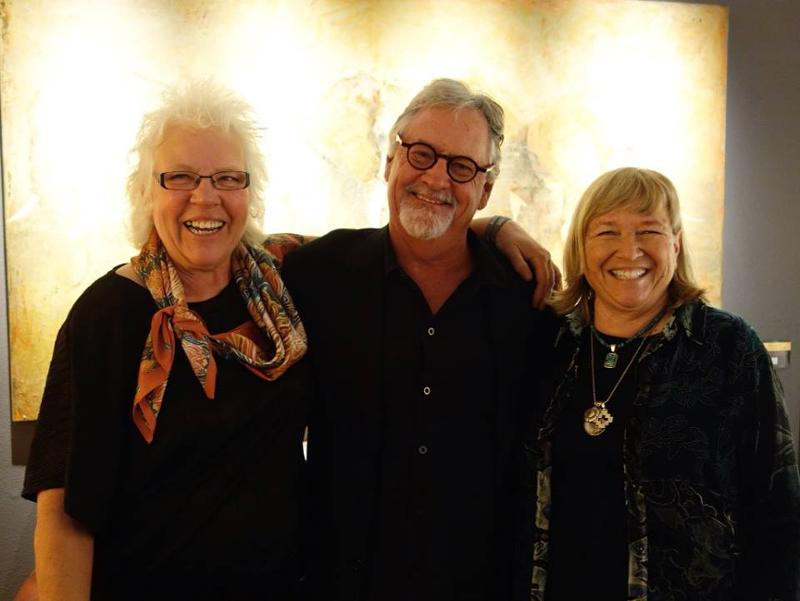 | |
Mary Roberson, Tom Mangelsen and Cynthia Moss happy after the art auction (Photo: Jutta Maue Kay)
|
| |
Cynthia travelled to Jackson Hole, Wyoming in June where she was hosted by long-time supporter and friend Ann Smith. Cynthia gave a lecture at the Center for the Arts, which Ann and Lisa Samford, Director of the Jackson Hole Wildlife Film Festival, organized. The next evening Cynthia participated in a fund raising event with Tom Mangelsen and Mary Roberson: Tom is a famous wildlife photographer and Mary is a very talented painter. Both have visited Amboseli recently just to photograph or paint the elephants. Their results in both cases are breathtaking.
Tom and Mary along with some other photographers donated their work for an auction with the proceeds going to ATE. Sue Cedarholm was the main organizer and it was a great success and fun as well with a professional auctioneer selling the artwork. We thank everyone involved for their generosity and their obvious concern for the elephants.
In addition to the auction Tom is donating $25 for every photo sold at his eight Images of Nature galleries. He will give the buyer a 25% discount on each sale. Click here to learn more.
|
Jasiri's Progress
| |
Jasiri was in very poor condition when he was rescued in Amboseli. He had been without his mother and without milk for three months. He needed special care at the David Sheldrick Wildlife Trust orphanage in his first month there and it was only because of their round-the-clock care that he survived. The expertise of the DSWT staff finally paid off and Jasiri is putting on weight and beginning to make friends with the other orphans. We are very grateful to DSWT for their skills. The photo above taken by one of our supporters, Chris Gordon, shows him feeding in his stall next to Faraja one of the other Amboseli orphans.
|
|
Oakland Zoo
| |
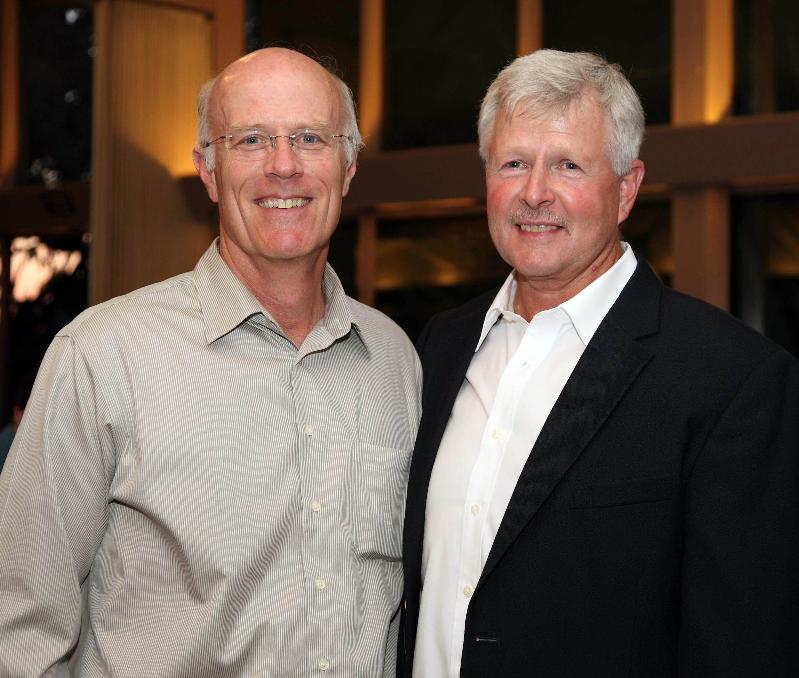 | |
Joel Parrott, Director of the Oakland Zoo, and Ed Stewart of PAWS
|
The Oakland Zoo's Celebrating Elephants events held in May brought in a record $32,000 for ATE. We are thrilled and want to thank all at the Zoo who worked so hard to make this year such a great success. We particularly want to thank Ed Stewart from PAWS for giving the lecture and drawing such a good crowd.
|
|
Archive of Past Newsletters
| |
Previous issues of the ATE newsletter can be found on our website: Archive
|
|
Give a Gift that Lasts Forever
| |
Include ATE in your bequest and estate planning. For a brochure on how to do that, contact Betsy Swart in our US office: eswart@elephanttrust.org.
|
|
|
News from the Amboseli Trust for Elephants
May-June 2013
|
Greetings!
We at ATE feel like we are riding a roller-coaster, there have been so many ups and downs in the last few weeks. Our lowest point is the ongoing court case we are dealing with. During the judicial process we have to refrain from discussing the case, but the few details we are able to release are in the Sidebar below.
However, to bring us back up we also have some good news to report on the achievements of two of our scholarship graduates (see Sidebar). In addition there have been some positive developments on poaching and the ivory trade. Pressure from local conservation groups has persuaded the Kenyan Parliament to pass legislation which radically increases the penalties for poaching and for possession and trafficking in wildlife products, with particular emphasis on ivory and rhino horn. Previously, a person found with ivory worth thousands of dollars could only be fined $500 and jail sentences were very light. Now someone can face seven years in prison and be fined the actual value of the illegal trophies.
More good news is also coming out of central Africa. The World Heritage Site of Dzanga-Sangha National Park in the Central African Republic is once again secured and conservation NGOs have been able to resume their work. In May rebels had entered the Park and slaughtered 26 elephants; as if this wasn't enough there were fears this was just the beginning of a large scale massacre in this magical and remote place. Andrea Turkalo has been studying the elephants there for over 20 years and I felt sick for her, knowing what I would feel if poachers came into the heart of Amboseli.
Finally, we are encouraged to read about a case in China where a licensed ivory dealer was sentenced to 15 years in jail for importing illegal ivory. Over a six-month period in 2011 the dealer imported 7.7 tons of ivory. The shipments consisted of 2,154 whole elephant tusks or segments and came from the equivalent of 819 elephants. Two of his colleagues were also convicted and jailed for seven years and 15 years respectively. This is the first conviction for insiders in the Chinese ivory industry laundering illegal ivory.
We have not even begun to win the war against poaching and ivory trafficking, but these victories help us to keep going.
Director
Amboseli Trust for Elephants
|
|
 |
|
Transformation of the EB Family by Cynthia Moss
In all the years that we followed the EBs up until Echo's death in 2009, it was the most sedentary of all the families in Amboseli. In fact we had to laugh at ourselves for putting a radio-collar on Echo back in 1974, because she hardly went anywhere.
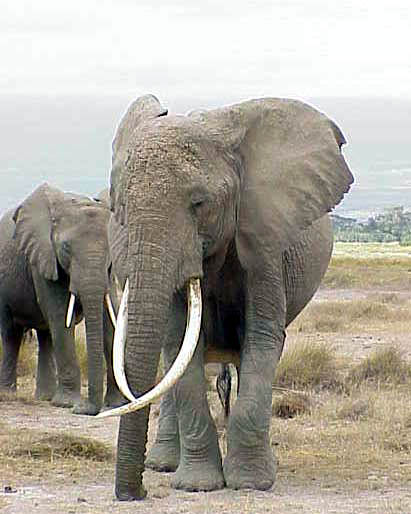 | |
Echo with a young Ebony
|
Echo was definitely a homebody and that was a good strategy for many years. When we first met the family in 1973 there were only seven members. By the time she died there were 41 females and calves, plus several independent adult males. The EBs did exceptionally well under Echo's leadership.
However, after she died and the drought ended, the family members recovered and we began to see some striking changes. The family broke down into subgroups with Ella leading one, Edwina another and Enid a third. Eudora, the second oldest female, sometimes spent time with Ella's section or with Enid's. This fission was not surprising; what was new and unusual was that they started moving around far more and much farther afield. In fact, first Ella and then the other subgroups could be found in different parts of the Park where they rarely went before. At times they would disappear all together.
The most recent disappearance lasted for nearly three months. I last saw them on 17 January; the ATE team sighted them in early March and that's when they recorded Emily Kate's and Elaine's new calves. Then the whole family vanished completely until 28 May when Enid's section was found along with Eudora and her new calf. Ella's and Edwina's subgroups were not with them.
 | |
Clockwork elephant: Eudora's daughter is full of life
|
We suspect and hope that all the EBs were up north in the Selengei Conservancy where there is an abundance of vegetation. It is also a safe area. Wherever they were they obviously found a good place because they were relaxed and very fat.
We were particularly happy to see Eudora with a new calf because our records show that she has not had the best of luck with both conceiving and keeping her calves. Over the years she has had seven calves of which three have died. Eudora's new calf is a female and that's good news because it will stay with her for the rest of her life. The calf is particularly adventurous and energetic. She reminds me of Ebony when she was a baby - so full of energy but not sure what to do with it. She ran, spun around, backed up, and charged all the time looking like a wind-up toy. It's hard to beat the joy of a baby elephant.
|
 |
|
State of the Population by Vicki Fishlock
The year 2009 was a terrible time in Amboseli. People, livestock and wildlife suffered appallingly in the grip of the worst drought in living memory. Since the drought broke in 2010, however, we have enjoyed several years of relative peace and prosperity with the elephants.
 | In your face! Elephants with time to spare are much more
likely to come and say hello |
Today's visitors to Amboseli notice, not the gaps in families left by the 354 deaths, but the 250 calves born since October 2011. These calves have survived in amazing numbers, charging around like little rugby players and proving that there is nothing in the world more captivating than baby elephants having fun.
It's not just the calves having a good time though. The vegetation recovered and a combination of decent rainfall and low grazing pressure (all the herbivore populations are increasing but remain below pre-2009 levels) has resulted in fat and happy elephants of every age.
Elephants usually spend around 20 hours a day feeding, but they're in such great shape now that everyone has more time to socialise and play. I found TeeJay and Terry, both 29-year-old bulls from the T families, literally having a cuddle: leaning against each other, Terry's ear covered TeeJay's face while they twined trunks and touched each other's faces. Greeting ceremonies between family members are a little more extravagant and flamboyant now that everyone has energy to spare.
The elephants hyper-respond to the Land Rover too; I have lost count of the number of silly rolling walks and eyes that have been directed to us in recent
 | |
The magnificent Tolstoy
|
weeks. Cynthia and I sat in camp and listened to a 30-minute play session of trumpets and rumbles: we were desperate to go out and see who was making such a ruckus but knew that our arrival would probably interrupt the fun. Reluctantly, we stayed put at our laptops, smiling.
Since the females are in such good condition they are ready to reproduce faster than normal, and those who gave birth in late 2011 and early 2012 are already coming into oestrus again. This is good news for the bulls; to be honest it's been a shame to see big males coming into musth when there have been no females available to mate with. Now there is stiff competition for the females, and we have been seeing lots of musth males guarding and mating females, and quite a few freshly broken tusks, indicating some serious fights.
All in Amboseli is as it should be, with wild elephants making the most of the good times.
|
 |
The History of the VA Family
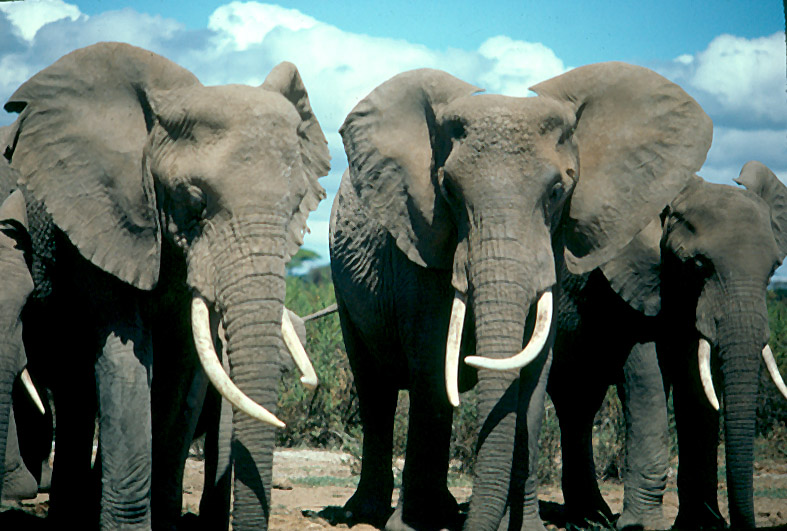 | |
Victoria & Virginia looked so alike that they must have been sisters
|
The VA family has always been a favorite of all the researchers who have worked on the project. From the beginning it has been a big, powerful family with big, powerful females, so that it was impossible not to be suitably impressed by them. Altogether we have documented 120 members of this family over the four decades we have known them. The family was first sighted in December 1973. At that time the average family size was 7, so this family of 18 was exceptionally large. What also made it striking was the presence of two beautiful females who looked very similar and seemed to be co-matriarchs, something I had not observed before. I suspected they were sisters. Whatever their relationship, they seemed to be very closely bonded.
In 1973 my colleague Harvey Croze and I were in the process of getting to know all the adults in the Amboseli population, and so as usual we photographed these beautiful females and their associates. In those days, there were no digital cameras and the precious rolls of film had to be transported to Nairobi, contact sheets printed, and exposure selection made before we could get a good look at the pictures. Only when the final identification photographs were printed could we assign names. The taller female became Virginia and her sister was called Victoria.
To read the whole history of the VA family Click Here. |
|
Amboseli Book Chapter Summary, 10: Vocal Communication and Social Knowledge
Chapter 10, Vocal Communication and Social Knowledge in African Elephants (Karen McComb, David Reby, and Cynthia J. Moss) describes the research that Karen McComb and colleagues conducted in Amboseli over the years. The work is premised on the fact that recording and playing back vocalizations to animals provides a very powerful tool both for investigating the ways in which they communicate as well as for revealing what is going on in their minds.
The chapter has two main strands. One leads readers through the process of investigating social knowledge in elephants using playbacks. It shows how the results from McComb's various studies combine to reveal the exceptionally extensive vocal recognition networks of elephants. It also underscores the key role that matriarchs play as repositories of social information for their families. The second strand aims to help readers make sense of the vocalizations themselves by providing user-friendly illustrations of how elephant contact calls differ between individuals and how they degrade with distance.
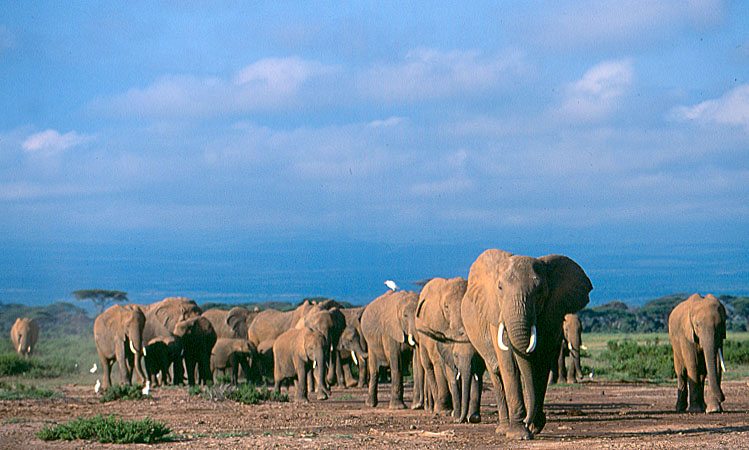 | |
Mariana, the old matriarch of the MA family, is a repository of knowledge
|
One of the most important findings in the chapter is that older matriarchs possess enhanced social knowledge: they are much more adept than younger females at distinguishing the played-back calls of genuine strangers from those of more familiar associates. In reacting appropriately - for example, by focusing defensive behaviour on situations where strangers are encountered, or by remaining relaxed when they hear calls from more familiar associates - the more experienced matriarchs ensure that their group functions efficiently by reserving appropriate action for genuine threats.
The experiments show how social knowledge and experience can translate into reproductive benefits. The results also demonstrate how, in a group of advanced social mammals such as elephants, the enhanced discriminatory abilities of the oldest individual can influence the social knowledge of the group as a whole. Crucially, if groups rely on older members for their store of social knowledge, then whole populations could be affected by the removal of a few key individuals.
|
|
We at ATE have many challenges right now but we are not going to let it stop us from pursuing our goal, which is a secure future for the Amboseli elephants as well as for elephants across Africa.
Cynthia Moss
Amboseli Trust for Elephants |
|
|